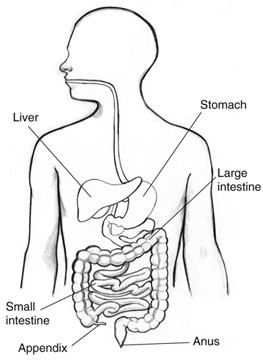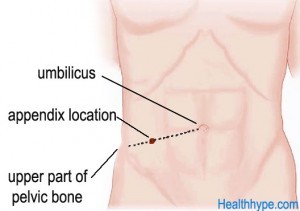Appendix Pain (Location) and Surgical Removal (Appendectomy)
Where Is Appendix Located?
Appendix is usually located in the right lower abdomen, between the navel and the upper part of the pelvic bone (Picture 1). The exact location differs from person to person, but is usually at or few inches around the McBurney’s point – two thirds of distance between the navel and upper part of the pelvis (Picture 1). Rarely, appendix is located on the opposite (left) side of the abdomen.
Picture 1: Appendix location: under the red spot,
or few inches away (in any direction)

Picture 2: Appendix is located on the beginning of the large intestine
(source: digestive.niddk.nih.gov)
Appendix Pain Causes
Acute appendicitis is the main cause of acute appendix pain. Appendix rupture may follow if treatment is delayed. Chronic appendicitis is also possible.
Symptoms and Signs of Acute Appendicitis
The following symptoms are usually present in acute appendicitis:
- Sudden pain around the navel that moves to the lower right abdomen in next hours.
- The painful spot is tender to touch and abdominal wall above the appendix is rigid.
- Pressure put (by hand) on the leftside of the abdomen and quickly released, triggers pain above the appendix (rebound tenderness, Rovsing sign).
- Pain worsens with coughing or moving around, or when you drop from standing on toes to heels quickly. Pain is often relieved by lying on the back with legs bent in the knees.
- Rarely — if the appendix is long or located on the right side (situs inversus) — pain can be felt in the lower left abdomen.
- Loss of appetite, nausea and vomiting occuring after the onset of pain. Vomiting before onset of pain speaks for bowel obstruction.
- Diarrhea or constipation may sometimes occur.
- Urinary symptoms, like urgency to empty the bladder, may appear.
- Low grade fever may be present.
High fever and rapid breathing may speak for appendix rupture. Usually only surgery reveals, if the appendix is ruptured or not.
Symptoms of Chronic Appendicitis
In chronic appendicitis, symptoms may slowly develop during several weeks.
In practise, diagnosis of appendicitis is not always easy, since there are several other possible causes of a right lower abdominal quadrant (RLQ) painarising from the abdominal wall (injury), skin (shingles), colon (constipation, Crohn’s disease), small intestine (hernia, adhesions), ovaries (twisted ovary), Fallopian tubes (ectopic pregnancy, pelvic inflammatory disease), ureter (urinary stones), bladder (infection), or testicles (torsion).
Diagnosis of Appendicitis
Inflamed appendix can be detected by CT or ultrasound in most cases. Blood test shows elevated white blood cells and C-reactive protein (CRP). Other causes of lower right abdominal pain should be considered.
Appendectomy (Appendicectomy)
Appendectomy, or appendicectomy, is the surgical removal of the appendix, which is a small, long sac attached to the first part of the large intestine. Appendicitis is the inflammation of the appendix and untreated acute appendicitis may lead to rupture of the appendix. Acute appendicitis is the most common surgical emergency and though mild cases may be treated with antibiotics, appendectomy is the treatment of choice.
Types of Appendectomy
There are two surgical techniques for appendectomy.
- Open appendectomy
- Laparoscopic appendectomy
Both operations are performed under general anesthesia.
Open Appendectomy
A small incision, about two to three inches, is made in the skin over the appendix location on the right side of the abdomen. The appendix is reached by cutting through the layers of the abdomen (skin, connective tissue and muscle) and then removed.
Laparoscopic appendectomy
This is a minimally invasive surgical technique where three or four tiny cuts are made in the abdomen through which a laparoscope, with a miniature camera and surgical instruments, are inserted into the abdominal cavity to remove the appendix.
Advantages of Laparoscopic Appendectomy
Laparoscopic appendectomy is often the preferred choice for the following reasons
- Quick healing time with smaller scar.
- Less post-operative pain and complications.
- Shorter hospital stay, since patients are discharged within 24 to 36 hours as compared to 2 to 5 days in the open method.
Contradictions for Laparoscopic Appendectomy
A laparascopic appendectomy may not be considered in the following pre-existing conditions due to the high risk of complications.
- Heart disease
- Chronic obstructive pulmonary disease
- Obesity
- Previous abdominal surgery



